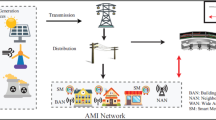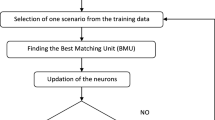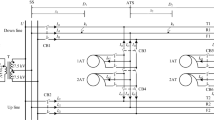Abstract
Successful fault management strategies are essential for implementing practical self-healing procedures in the automated distribution systems. Such tools effectively decrease repairing times by precise detecting and locating the deteriorated components in distribution networks. In this paper, the reliability analysis is computed using dynamic distribution network measurements for a modified autonomous control according to the most common IEEE reliability indices. The reliability of the proposed management control method is enhanced by reducing the number of communication hops. Also, the reliability of the proposed control is compared with both that of the actual control method using recorded data along six months and that of applying other advanced methods in same actual system using Markov model analysis. The results confirm the efficacy of the proposed fault management for enhancing distribution network reliability and service continuity.
















Similar content being viewed by others
References
Zidan A, Khairalla M, Abdrabou AM, Khalifa T, Shaban K, Abdrabou A, El-Shatshat R, Gaouda A (2017) Fault detection, isolation, and service restoration in distribution systems: state-of-the-art and future trends. IEEE Trans Smart Grid 8(5):2170–2185
Sherbilla NF, Elsadd MA, Kawady TA, Elkalashy NI, Taalab AI (2019) Autonomous backup selectivity technique for line-to-ground faults in automated distribution networks. In: 2019 21st international middle east power systems conference (MEPCON), Cairo, Egypt, pp 952–957
Abood O, Elsadd M, Guirguis S (2017) Investigation of cryptography algorithms used for security and privacy protection in smart grid. In: Nineteenth international middle east power systems conference (MEPCON), December 2017
Abood O, Elsadd M, Guirguis S (2019) Incorporating deoxyribonucleic acid in AES scheme for enhancing security and privacy protection. J Theor Appl Inf Technol 97(02):349–360
Billinton R, Allan RN (1996) Reliability evaluation of power system, 2nd edn. Plenum Press, New York
Brown RE, Hanson AP, Willis HL, Luedtke FA, Bron MF (2001) Assessing the reliability of distribution systems. IEEE Comput Appl Power 14(1):44–49
Brown RE (2009) Electric power distribution reliability, 2nd edn. Marcel Dekker, New York
Qia Q, Wua J, Zhang L, Chenga M (2016) Multi-objective optimization of electrical distribution network operation considering reconfiguration and soft open points. Applied energy symposium and forum, renewable energy integration with mini/microgrid, Maldives, 19–21 April 2016
Duan B, Li G, Qiu C, Pan J, Tan Y (2012) Fault location and self-healing of distribution network based on function block and wireless sensor. Innovative Smart Grid Technologies (ISGT), Washington, USA, 16–18 January 2012, IEEE Xplore, 3 April 2012
Brint AT, Hodgkinns WR, Rigler DM, Smith SA (1998) Evaluation strategies for reliable distribution. IEEE Comput Appl Power 11(3):43–47
Short T, Taylor L, Power D (2004) Practical approaches to reliability improvement, transmission & distribution world
Zahran AD, Elkalashy NI, Elsadd MA, Kawady TA, Taalab AI (2017) Improved ground distance protection for cascaded overhead-submarine cable transmission system. Nineteenth International Middle East Power Systems Conference (MEPCON). Egypt, Cairo, pp 778–758
Zhou Y, Spare JH (2007) Optimizing reliability project portfolios for electric distribution companies. In: Proceedings of the 2007 IEEE power engineering society general meeting, pp 1–5
Kazemi S, Lehtonen M, Fotuhi-Firuzabad M (2012) Impact of fault diagnosis schemes on distribution system reliability. IEEE Trans Smart Grid 3(2):720–727
Salim RH, Caino de Oliveira KR, Filomena AD, Resener M, Bretas AS (2008) Hybrid fault diagnosis scheme implementation for power distribution systems automation. IEEE Trans Power Deliv 23(4):1846–2185
Tarnate WRD, Cruz IBNC, Del Mundo RD, Malquisto BM (2012) Maximizing service restoration in reliability optimization of radial distribution systems. In: TENCON IEEE region 10 conference, Cebu, pp 1–6
Hajian-Hoseinabadi H, Hasanianfar M, Golshan MEH (2012) Quantitative reliability assessment of various automated industrial substations and their impacts on distribution reliability. IEEE Trans Power Deliv 27(3):1223–1233
Nordman M, Lehtonen M (2005) An agent concept for managing electrical distribution networks. IEEE Trans Power Deliv 20(2):696–703
IEEE std 1366–1998. Trial-use guide for electric power distribution reliability indices
Distribution Reliability Working Group, IEEE Benchmark Year 2017 Results for 2016 Data 2017. http://grouper.ieee.org/groups/td/dist/sd/doc/Benchmarking-Results-2016.pdf
Brown R, Gupt S, Chriite R, Venkta S, Fleetecher R (1996) Distribution system reliability assessment using hierarchical Markov modeling. IEEE Trans Power Deliv 11(4):1929–1934
Meeuwse J, Klng WL, Ploem W (1997) The influence of protection system failures and preventive maintenance on protection system in distribution systems. IEEE Trans Power Deliv 12(1):125–133
Allen RN, Billinton R, Sjarief I, Goel L, So KS (1991) A reliability test system for educational purpose-basic distribution system data and results. IEEE Trans Power Syst 6(2):813–820
Billinton R, Allan RN (1984) Reliability evaluation of power systems. Pitman Books, Boston
Endrenyi J (1978) Reliability modeling in electric power systems. Wiley, Chichester
IEEE Std (1998) 493-1997 Chapter 8, Basic concepts of reliability analysis by probability methods. In: IEEE
Singh C (1989) Reliability assessment of composite generation and transmission systems. Basic Probability and reliability concepts. In: IEEE Tutorial Course, 90EH0311-PWR
Zhabelova G, Vyatkin V (2012) Multiagent smart grid automation architecture based on IEC61850/61499 intelligent logical nodes. IEEE Trans Ind Electron 59(5):2351–2362
Elsadd M, Elkalashy N, Kawady T, Taalab A (2017) Earth fault location determination independent of fault impedance for distribution networks. Int Trans Electr Energy Syst 27(5):2389–2398
Elsadd MA, Elkalashy NI, Kawady TA, Taalab A-MI, Lehtonen M (2016) Incorporating earth fault location in management control scheme for distribution networks. IET Gen Transm Distrib 10(10):2389–2398
Tarhuni N, Elkalashy N, Kawady T, Lehtonen M (2015) Autonomous control strategy for fault management in distribution networks. J Elect Power Syst Res 121:252–259. https://doi.org/10.1016/j.epsr.2014.11.011
Author information
Authors and Affiliations
Corresponding author
Appendix
Appendix
1.1 Parameters of the simulated system
The system consists of two overhead parallel incoming feeders, cascaded with one outgoing cable feeder. The buses are renumbered for simplicity, 64 normally closed switches located at each section terminals while one circuit breaker is added at the beginning of the feeder. Also, normally open switches (Tie switches) are added to the system to verify system reconfiguration. Each of the overhead parallel incoming feeder parameters is illustrated in Table
5.
This outgoing feeder is characterized by the positive sequence data of the feeder and loads listed in Table
6. The positive and zero sequence resistance are equal to 1.62, 0.5 (Ω/ km), respectively, while the positive and zero sequences inductance are equal to 3.82, 7.14 (mH/km), respectively, the positive and zero sequence capacitances are equal to 0.0067 and 0.0041 µf/km, respectively. Also, wind turbine data are introduced in Table
7.
1.2 Utilized master control system
The Master Control Center (SCADA) consists of seven parts as outlined in Fig.
17. Through which collect all real-time data incoming from the remote terminal unit as well as the operations of existing control in any substations (primary substation distribution panel), and secondary substation (transformers). This part collects all data in the Master Control Center using the local remote terminal unit. This part performs all operation control and sends real-time data to all units of computers located in the master center through the local area network. The second part is called the information management server (IMs). This part is composed of a server in addition to the external storage unit containing a central data database for medium voltage network components and real-time data received from data collection (RTC/TCS). These data stored on external drives can be retrieved when needed. Through this part is being built power system analysis such as (fault detection—load flow—short circuit calculation). A third part called dispatcher workstation (electrical engineer). Using SCADA system, the electrical engineer can be monitoring for primary substation 66/11 kV, and control the distribution panel 11 kV, and the operation of secondary substations. In addition to, the section manger can be monitoring the continuity of electricity service in all network, and safety equipment performance for the master center. The fourth part is called supervisory workstation, which controls all works as well as routine maintenance, removal of software failure, and monitors the status of communication between the master center and external sites. The fifth part is called the rear protection system, through which the display monitors are enlarged to follow up the operation, control of the electric grid. The sixth part is called time system and its purpose is to adjust the synchronization between the master center, remote terminal unit, and digital protection relays in the outstation.
The seventh part is called local area network (LAN), which connects various computer units in the master center of each other. This part is used to transfer the information between the connecting unit. Further components were added to the system such as system recorders where the current and voltage measurements are recorded by digital relays during normal operation and fault conditions. The communications between the protection relays, distributions panels, and control center were based on the standard protocol communication IEC60870. This protocol facilitated transmissions and communications of fault indications, measured values, and commands.
Rights and permissions
About this article
Cite this article
Esmail, E.M., Elkalashy, N.I., Kawady, T.A. et al. Modified autonomous fault management strategy for enhancing distribution network reliability. Electr Eng 104, 233–248 (2022). https://doi.org/10.1007/s00202-021-01216-6
Received:
Accepted:
Published:
Issue Date:
DOI: https://doi.org/10.1007/s00202-021-01216-6





